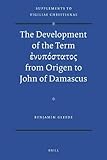The development of the term [enypostatos] from Origen to John of Damascus / by Benjamin Gleede.
Material type: TextSeries: Supplements to Vigiliae Christianae ; v. 113.Publication details: Leiden ; Boston : Brill, 2012.Description: 1 online resource (vii, 210 pages)Content type:
TextSeries: Supplements to Vigiliae Christianae ; v. 113.Publication details: Leiden ; Boston : Brill, 2012.Description: 1 online resource (vii, 210 pages)Content type: - 9789004227996
- 9004227997
- 1280496215
- 9781280496219
- 900422419X
- 9789004224193
- Jesus Christ -- Natures -- History of doctrines -- Early church, ca. 30-600
- Jesus Christ -- History of doctrines -- Early church, ca. 30-600
- Jésus-Christ -- Histoire des doctrines -- ca 30-600 (Église primitive)
- Jesus Christ
- Hypostatic union -- History of doctrines -- Early church, ca. 30-600
- RELIGION -- Christian Theology -- Christology
- Theology, Doctrinal
- 30-600
- 232.09015
- BT213 .G54 2012eb
- online - EBSCO
| Item type | Current library | Call number | URL | Status | Notes | Barcode | |
|---|---|---|---|---|---|---|---|
 eBook
eBook
|
Biblioteca "Angelicum" Pont. Univ. S.Tommaso d'Aquino Nuvola online | online - EBSCO (Browse shelf(Opens below)) | Online access | Not for loan (Accesso limitato) | Accesso per gli utenti autorizzati / Access for authorized users | (ebsco)456875 |
On t.p. "enypostatos" appears in the Greek alphabet.
Revision of the author's thesis (MA)--Durham University, 2004.
Includes bibliographical references (pages 189-200) and indexes.
Acknowledgements; Abbreviations; Introduction; Part I. The Pre-Neochalcedonian enupostatos-Tradition; 1. The Origin of the Term; 1.1. Basic Considerations; 1.2. Enupostatos -- A Genuinely Christian Theological Term; 1.2.1. Irenaeus?; 1.2.2. Origen; 1.2.3. Origin and the Genuine Meaning(s) of the Term; 2. Enupostatos as a Technical Term of Trinitarian Theology; 2.1. The Rise and Development of a Technical Usage during the Arian Controversy; 2.1.1. A First Instance of Theological Relevance: The Letter of the Six Bishops. 2.1.2. A 'Third Kind' of Logos: proforikos, endiathetos, enupostatos2.1.3. The Hypostatical Independence of the Logos in the Creeds; 2.2. The Establishment of the Technical Usage in Late Fourth- and Early Fifth-Century Authors; 2.2.1. Ps-Athanasius and Didymus; 2.2.2. Epiphanius of Salamis; 2.2.3. John Chrysostom; 2.2.4. Cyril of Alexandria; Part II. The Christological Application of enupostatos; Introduction; 3. enupostatos, the 'Insubsistence Formula', Their Connection and Relevance for Post-Chalcedonian Christology during the Sixth-Century Debate. 3.1. John the Grammarian and the Introduction of enupostatos into the Christological Debate3.1.1. Enupostatos and Insubsistence in JohnÕs Apology for Chalcedon; 3.1.2. Background and Possible Sources; 3.2. Leontius of Byzantium and the Distinction between enupostaton and hupostasis; 3.2.1. Interpreting the ÔLocus ClassicusÕ; 3.2.2. Leontius and the Insubsistence Formula; 3.3. Philosophical Excursus: The Distinctio kath' hauto -- en alloi, the Problem of Substantial Qualities and Inexisting Natures; 3.3.1. Origin and Problems of the Distinction. 3.3.2. Attempted Solutions in the Later Commentaries on Aristotle3.3.3. Inherence of Accidents; 3.3.4. Inherence of Substantial Parts (Specific Differences, Substantial Qualities); 3.3.5. Inherence of Genera and Species; 3.3.5.1. The Problem of Participation; 3.3.5.2. The Problem of Individuation and Immattered Forms; 3.4. Ephrem of Amid; 3.5. Pamphilus the Theologian; 3.5.1. Pamphilus Reading Leontius of Byzantium; 3.5.2. Complementary Neochalcedonian Arguments: Pamphilus and the Insubsistence Formula. 3.6. De sectis, Anastasius of Antioch and the Christological Disadvantages of the Common Usage3.6.1. De sectis, Praxis VII; 3.6.2. Anastasius I. of Antioch, the Disadvantages of the Common Usage and the Systematical Problems of Insubsistence-Christology; 3.7. Leontius of Jerusalem; 3.7.1. Leontius' Usage of enupostatos; 3.7.2. Leontius and the Insubsistence Formula; 4. enupostatos, the 'Insubsistence Formula', Their Connection and Relevance for the Culmination of Chalcedonian Christological Thought; 4.1. Maximus the Confessor; 4.1.1. Maximus' Usage of enupostatos. 4.1.2. The Insubsistence Formula in Maximus.
Examining the usage of the term enypostatos throughout the Patristic period, this study illustrates the gradual change in its meaning from stressing the hypostatical independence of the trinitarian persons to upholding the reality of Christ's two natures in his unique hypostasis.
Print version record.


